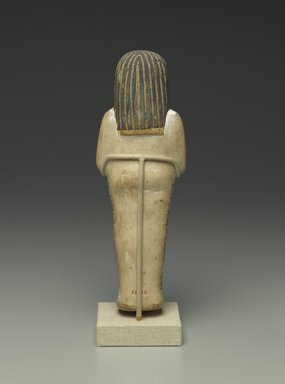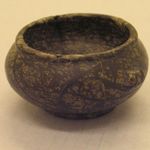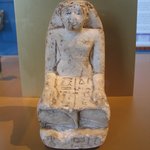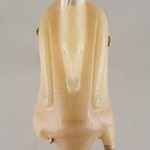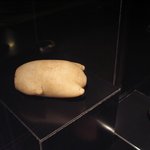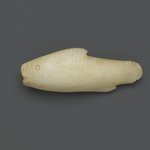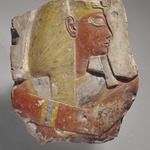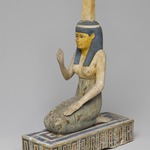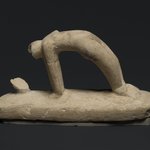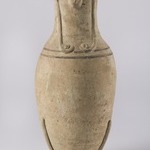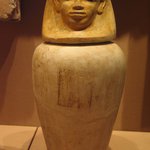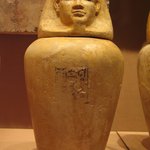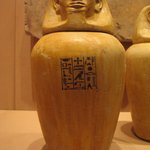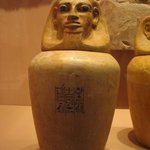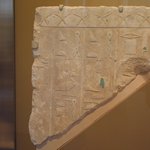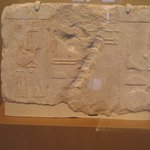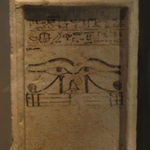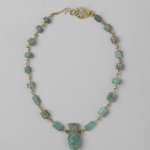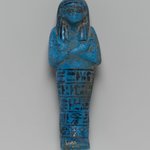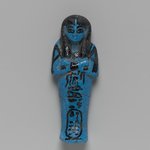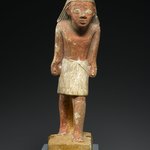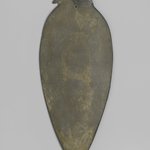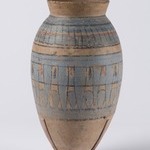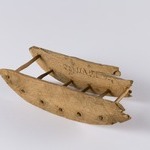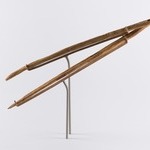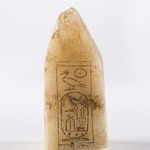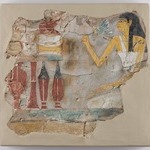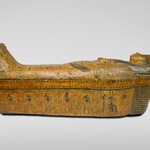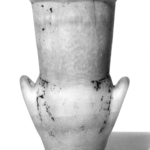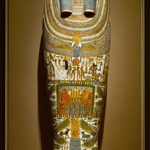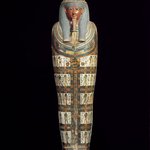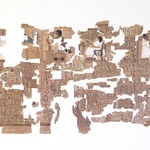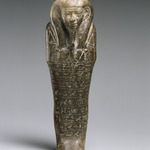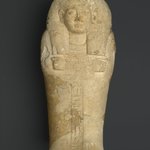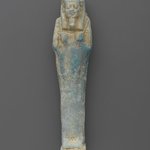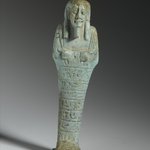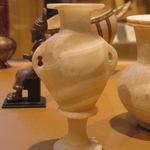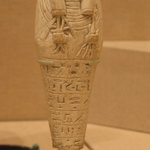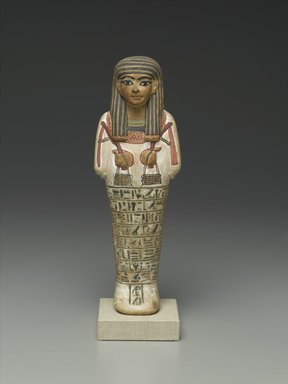

Shabty of Amunemhat, ca. 1400–1336 B.C.E. Limestone, pigment, 9 3/4 × 3 5/8 × 2 1/2 in. (24.8 × 9.2 × 6.4 cm). Brooklyn Museum, Charles Edwin Wilbour Fund, 50.128. Creative Commons-BY (Photo: Brooklyn Museum, 50.128_front_PS2.jpg)

Shabty of Amunemhat, ca. 1400–1336 B.C.E. Limestone, pigment, 9 3/4 × 3 5/8 × 2 1/2 in. (24.8 × 9.2 × 6.4 cm). Brooklyn Museum, Charles Edwin Wilbour Fund, 50.128. Creative Commons-BY (Photo: Brooklyn Museum, 50.128_threequarter_right_PS2.jpg)
Shabty of Amunemhat
Egyptian, Classical, Ancient Near Eastern Art
Shabties were made from stone, wood, faience, and (rarely) metal depending on the tomb owner’s priorities. Amunemhat had a smaller number of very fine shabties, including the painted stone example shown here and a wooden example exhibited nearby. The uninscribed shabty also shown here is one of up to 360 examples—one for each day of the Egyptian year—molded in faience, an inexpensive ceramic material made from sand.
Shabties magically performed agricultural work required of the deceased in the afterlife.
Shabties magically performed agricultural work required of the deceased in the afterlife.
MEDIUM
Limestone, pigment
DATES
ca. 1400–1336 B.C.E.
DYNASTY
Dynasty 18
PERIOD
New Kingdom
DIMENSIONS
9 3/4 × 3 5/8 × 2 1/2 in. (24.8 × 9.2 × 6.4 cm)
mount: 10 × 3 1/2 × 2 1/2 in. (25.4 × 8.9 × 6.4 cm) (show scale)



COLLECTIONS
Egyptian, Classical, Ancient Near Eastern Art
ACCESSION NUMBER
50.128
CREDIT LINE
Charles Edwin Wilbour Fund
CATALOGUE DESCRIPTION
Painted limestone ushabti of the Watcher of Amon, the scribe Amenmhet. Conventional mummiform type with each hand grasping hoe and basket. Striped lappet wig and large necklace. Eight lines of inscription around body with single short column at base. Details painted yellow, blue, green and red.
Condition: Intact. White paint worn from front surface.
MUSEUM LOCATION
This item is not on view
CAPTION
Shabty of Amunemhat, ca. 1400–1336 B.C.E. Limestone, pigment, 9 3/4 × 3 5/8 × 2 1/2 in. (24.8 × 9.2 × 6.4 cm). Brooklyn Museum, Charles Edwin Wilbour Fund, 50.128. Creative Commons-BY (Photo: Brooklyn Museum, 50.128_front_PS2.jpg)
IMAGE
front, 50.128_front_PS2.jpg. Brooklyn Museum photograph, 2007
"CUR" at the beginning of an image file name means that the image was created by a curatorial staff member. These study images may be digital point-and-shoot photographs, when we don\'t yet have high-quality studio photography, or they may be scans of older negatives, slides, or photographic prints, providing historical documentation of the object.
RIGHTS STATEMENT
Creative Commons-BY
You may download and use Brooklyn Museum images of this three-dimensional work in accordance with a Creative Commons license. Fair use, as understood under the United States Copyright Act, may also apply.
Please include caption information from this page and credit the Brooklyn Museum. If you need a high resolution file, please fill out our online application form (charges apply).
For further information about copyright, we recommend resources at the United States Library of Congress, Cornell University, Copyright and Cultural Institutions: Guidelines for U.S. Libraries, Archives, and Museums, and Copyright Watch.
For more information about the Museum's rights project, including how rights types are assigned, please see our blog posts on copyright.
If you have any information regarding this work and rights to it, please contact copyright@brooklynmuseum.org.
RECORD COMPLETENESS
Not every record you will find here is complete. More information is available for some works than for others, and some entries have been updated more recently. Records are frequently reviewed and revised, and we welcome any additional information you might have.

